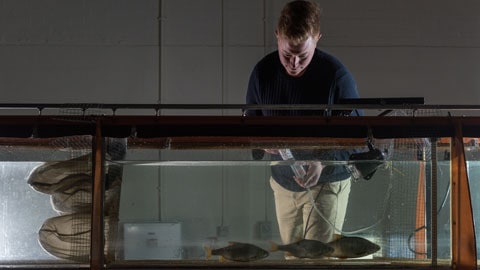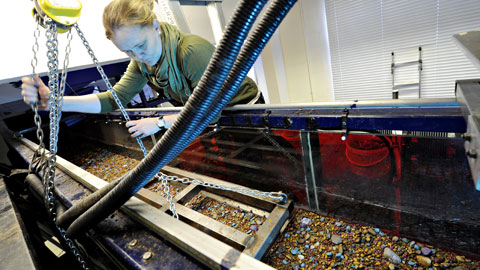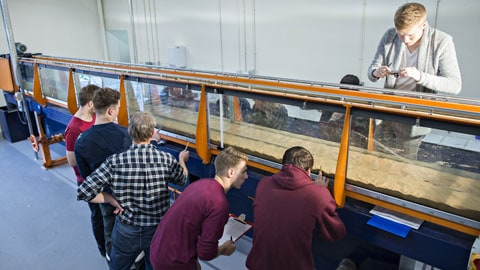River science laboratory
The River Science Laboratory (RSL) supports our experimental research at the interface of river geomorphology, freshwater ecology and open-channel hydraulics.
It houses two 10m long, tilting, glass-sided flumes (one 300mm wide, one 600mm wide) capable of recirculating fine sediment and with a variable-speed sediment feed system. Instrumentation for measuring flow hydraulics and bed morphology includes a Dantec Particle Image Velocimetry system, Acoustic Doppler Velocimeters, and a traverse-mounted laser scanner.
A particular focus in the RSL is on interactions between living organisms, near-bed hydraulics and sediment transport. The lab is therefore equipped with suitable aquaria and environmental controls to ensure excellent husbandry of plants, fish, crustacea and invertebrates.
Papers from research undertaken in the River Science Laboratory (Flumes, Mesocosms, Other)
- Sanders H, Rice SP, Wood PJ. (2021) Signal crayfish burrowing, bank retreat and sediment recruitment to rivers: a biophysical sediment budget, Earth Surface Processes and Landforms, 46: 837–852
- Vettori D, Rice SP (2020) Implications of environmental conditions for health status and biomechanics of freshwater macrophytes in hydraulic laboratories, Journal of Ecohydraulics, 5: 71-83
- Han X, Fang H, Johnson MF, Rice SP (2019) The impact of biological bedforms on near-bed and subsurface flow: a laboratory evaluated numerical study of flow in the vicinity of pits and mounds, Journal of Geophysical Research: Earth Surface 124: 1939-1957
- Mason R, Rice SP, Wood PJ, Johnson MF (2019) The zoogeomorphology of case-building caddisfly: quantifying sediment use, Earth Surface Processes and Landforms 44: 2510-2525
- Mathers K, Rice SP, Wood PJ (2019) Predator, prey and substrate interactions – the role of faunal activity and substrate characteristics, Ecosphere
- Cooper J, Ockelford A, Rice SP, Powell DM. (2018) Does the Permeability of Gravel River Beds Affect Near-bed Hydrodynamics? Earth Surface Processes and Landforms, 43, 943–955
- Pledger AG, Rice SP, Millett J. (2017) Foraging fish as zoogeomorphic agents: An assessment of fish impacts at patch, barform, and reach scales. Journal of Geophysical Research: Earth Surface, 122: 2105–2123
- Powell DM, Ockelford A, Rice SP, Hillier JK, Nguyen T, Reid I, Tate NJ, Ackerley D. (2016) Structural properties of mobile armours formed at different transport intensities in gravel-bed rivers. Journal of Geophysical Research – Earth Surface, 121: 1494–1515
- Pledger AG, Rice SP, Millet J. (2016) Bed disturbance via foraging fish increases bedload transport during subsequent high flows and is controlled by fish size and species. Geomorphology 253: 83-93
- Pledger AG, Rice SP, Millet J. (2014) Reduced bed material stability and increased bedload transport caused by foraging fish: a flume study with juvenile Barbel (Barbus barbus). Earth Surface Processes and Landforms 39: 1500-1513
- Rice SP, Buffin-Bélanger T, Reid I. (2014) Sensitivity of interfacial hydraulics to the microtopographic roughness of water-lain gravels. Earth Surface Processes and Landforms 39: 184–199
- Johnson MF, Rice SP and Reid I. (2011) Increase in coarse sediment transport associated with disturbance of gravel river beds by signal crayfish (Pacifastacus leniusculus). Earth Surface Processes and Landforms 36: 1680-1692
- Johnson MF, Rice SP and Reid I. (2010) Topographic disturbance of subaqeous gravel substrates by signal crayfish (Pacifastacus leniusculus). Geomorphology 123: 269-278
- Oldmeadow DF, Lancaster J and Rice SP. (2010) Drift and settlement of stream insects in a complex hydraulic environment. Freshwater Biology 55: 1020-1035
- Patel, C., Vadher, A.N., Mathers, K.L., Dwyer, C. and Wood, P.J., 2021. Body size affects the vertical movement of benthic amphipods through subsurface sediments in response to drying. Hydrobiologia, 848: 1015-1025.
- Beatty, C., Mathers, K.L., Patel, C., Constable, D. and Wood, P.J., 2020. Substrate mediated predator–prey interactions between invasive crayfish and indigenous and non-native amphipods. Biological Invasions, 22(9), pp.2713-2724.
- Mckenzie, M, Mathers, K.L., Wood, P.J., England, J., Forster, I., Lawler, D. and Wilkes, M (2020). Physical effects of suspended fine sediment on lotic macroinvertebrates. Hydrobiologia. 8467, 697-711.
- Clinton, K.E., Mathers, K.L., Constable, D., Gerrard, C. and Wood, P.J. (2018) Substrate preferences of coexisting invasive amphipods, Dikerogammarus villosus and Dikerogammarus haemobaphes, under field and laboratory conditions. Biological Invasions. 20, 2187-2196
- Vettori, D., Marjoribanks, T.I. (2021) Temporal Variability and Within-Plant Heterogeneity in Blade Biomechanics Regulate Flow-Seagrass Interactions of Zostera marina. Water Resources Research 57(3): e2020WR027747
Funders of our research in the River Science Laboratory
- British Society for Geomorphology
- Environment Agency
- European Commission
- NERC
PhDs from the River Science Laboratory
- David Oldmeadow. 2005. Patch-specific disturbance –a geomorphic framework in streams
- Matthew Johnson. 2011. An experimental investigation of the interactions between crayfish activity, fine sedimentation and gravel-bed stability
- Andrew Pledger. 2015. Zoogeomorphology of selected UK freshwater fish
- James Smith. 2019. Ecosystem engineering by Bream in lowland rivers
- Kate Mathers. 2017. Signal crayfish impacts on fauna and fine sediment dynamics in lowland rivers
- Richard Mason. 2020. The zoogeomorphology of case-building caddisfly larvae.
- Harry Sanders. 2020. Biotic and abiotic controls of burrowing by signal crayfish and the implications for sediment recruitment to rivers.
- Bethany Worley. Biocontrol of invasive crayfish using European eels and the implications for river geomorphology and flood risk (EA), expected 2021
MScs from the River Science Laboratory
- Cathrine Beatty - Substrate mediated predator-prey interactions between the invasive Signal Crayfish (Pacifastacus leniusculus, Dana 1852) and two non-native and one native species of amphipod from freshwater systems in the Midlands, UK.
- Charlie Patel - The influence of drying, substrate and head size on the use of the hyporheic zone by native and non-native amphipods
- Kelly Clinton - Field distribution and substrate preferences of the invasive ‘Killer’ and ‘Demon’ shrimps (Dikerogammarus villosus and Dikerogammarus haemobaphes) in a lowland reservoir
- Harley Nicholls - Flowing Fibres: An experimental investigation into the influence of fibre type and flow conditions on microfibre transport in rivers.
- Henry Moody – Validating an artificial intelligence imaging system for the monitoring of plastic in the environment.
Recent visitors to the River Science Laboratory
- Xu Han, PhD student (Tsinghua University, China) working with Matt Johnson (University of Nottingham) on biogenic bedforms
- Dan Mills, PhD student, (Kings, London) twho worked on an experimental chapter in his thesis, 'Ecological impacts of a new invasive species in UK rivers the quagga mussel, Dreissena rostriformis bugensis (Bivalva: Dreissenidae; Andrusov 1897)'
- Alistair Delboyer (University of Nottingham) working with Matthew Johnson on thermal plumes in turbulent flows
- Dr Lindsey Albertson (Montana State University) working with Prof. Stephen Rice (Manchester Metropolitan University), Prof. Paul Wood and Dr. Kate Mathers on a Fulbright Scholarship looking at ecosystem engineering and invasive species.


